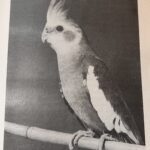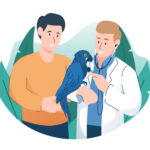
This is your bird. This is your bird on SEED.
Many of the companies that make pellets have pictures such as these on their websites or as handouts that are given to vets. They purport to demonstrate what birds look like on seed diets and their radical transformation after being switched to pellets.
If a vet gives you a handout like this, now you know where it comes from. As an aside, it’s a little known fact that vets are paid by pellet manufacturers to exclusively feature their products. This is why vets often only have one brand for sale in their waiting room.
So, I want to start by analyzing some of these before and after pictures and the accompanying text. For example:
VEGAN was solely on seeds and showing early signs of fatty liver disease. Recovering photo reveals dramatic improvements in beak and feather quality.
- There is no mention of fresh food. What likely happened here is that, when encouraging the bird owner to switch to pellets, they also were told to start feeding fresh food. Which is the actual reason for improved feather quality?
- What did the seed diet consist of? As I wrote about in “Are seeds high in fat?” and “The real reasons the all seed diet is bad“, the most common seeds in some bird seed mixes are very low in fat. The less common ones are high in fat. Seed diets can be radically different depending on the mix of seeds.
- Even if the diet were high in fat, this is not the reason for fatty liver disease as I wrote about “What causes Fatty Liver Disease?“
GABI the African Grey was on a diet of seed-balls, seeds and various table foods. She developed an ongoing yeast problem and subsequently feather plucked herself. Gabi was put on Harrison’s by her avian veterinarian and immediately turned things around.
- What sort of table foods? Did the vet suggest discontinuing them? Might that be the reason for the feather condition change?
- They say a yeast problem caused her to pluck. Do seeds cause yeast problems? Not that I could find.
- Did pellets make the yeast problem go away? No, it didn’t.
- To summarize, they treated a yeast problem, they were told to cut out the table foods, and were switched to pellets. Somehow the recovery was because of the pellets.
RICA the Amazon Parrot recovered from being overweight and showing classic signs of improper nutrition poor (discolored and frayed) feather and quality while on a seed and tablefood diet.
She was in a constant state of molting. Rica’s improvements on Harrison’s are quite remarkable.
- What table foods did she eat? Could stopping her from eating them have helped?
- What was the composition of the seed diet? Could be very high fat, could be very high carbohydrate, depending on the mix of seeds.
LOGAN the cockatiel was suffering from poor feather quality with many broken feathers. She was given to new owners who weaned her to Harrison’s and she has improved dramatically.
- No mention of diet, table food, anything else.
One thing never mentioned in any of these is the environment a bird lives in. Just like humans, our health and physical appearance are affected by our environment and the effect it has on our mental and physical health.
Observations
I always ask when I see a bird what they are fed. Sadly, I’ve not kept track of this information! But my recollection is that most people use pellets and I see a lot of birds that look worse than mine. No one has really studied this in parrots.
Conclusion
Don’t be seduced by photos like this. Ask questions. Ask for research to back up the claims of pellet manufactures and vets.

